Megjegyzések / Kérdések (221)
![]() Carmen LEMAIRE írta:
Carmen LEMAIRE írta:
Bonjour Je bloque au niveau A 17 cm de hauteur total 4 rang point mousse au dessus des 20 mailles centrales sur les côtes 10 maille de chaque côtés on fait comment on tricote de quel marqueur s'agit il cotes emmanchures sinon fait chaque marqueur ça fait un total de 40 maille poit mousse Merci d’avance
23.06.2025 - 06:12A DROPS Design válasza:
Bonjour Mme Lemaire, ça fait effectivement un total de 40 m point mousse mais vous n'aurez que 20 mailles pour chaque emmanchure, autrement dit, 2ème taille: tricotez comme avant jusqu'à ce qu'il reste 10 m avant le 1er marqueur, tricotez les 20 m suivantes au point mousse, tricotez comme avant jusqu'à ce qu'il reste 10 m avant le 2ème marqueur, tricotez les 20 m suivantes au point mousse et terminez comme avant. Tricotez ainsi 4 rangs, puis rabattez 10 m pour chaque emmanchure = 5 de chaque côté de chaque marqueur, il reste 5 m de bordure d'emmanchure au point mousse pour chaque devant et de chaque côté pour le dos. Bon tricot!
23.06.2025 - 08:38
![]() Lemaire Carmen írta:
Lemaire Carmen írta:
Bonjour je tricote le gilet en 6/9mois J en sui5a: Tricoter 4 rg point mousse continuer en double point de riz pendant combien cm? Et je comprends pas du tout comment faire les diminutions pour les devant et le dos Merci de votre aide
17.06.2025 - 17:01A DROPS Design válasza:
Bonjour Mme Lemaire, jusqu'à ce que l'ouvrage mesure 17 cm de hauteur totale dans la 2ème taille, vous allez ensuite former l'encolure (tricotez d'abord 2 rangs raccourcis sur les mailles de bordure devant de chaque côté), puis diminuez pour l'encolure, et, en même temps, formez les emmanchures en tricotant 4 rangs point mousse sur les 20 m de chaque côté (bordure sous les bras) - tricotez les autres mailles comme avant, et rabattez 10 m de chaque côté et terminez le dos et les devants séparément. Bon tricot!
18.06.2025 - 07:27
![]() Nicola írta:
Nicola írta:
Hi. With regard to the back piece, I have 56 stitches and now decreasing for the armholes. It says dec 1st every other row from RS a total of 6 times = 44 st. How does that work (56 - 6 = 50) ... am I decreasing each side? Thanks for any help, Nicola
13.06.2025 - 01:32A DROPS Design válasza:
Hi Nicola, Yes, you decrease on each side of the back piece for the armholes, 1 stitch x 6 = 12 stitches in total. Regards, Drops team.
13.06.2025 - 06:07
![]() Nicola írta:
Nicola írta:
Hi. With regard to the back piece, I have 56 stitches and now decreasing for the armholes. It says dec 1st every other row from RS a total of 6 times = 44 st. How does that work (56 - 6 = 50) ... am I decreasing each side? Thanks for any help, Nicola
12.06.2025 - 23:20A DROPS Design válasza:
Dear Nicola, correct on back piece you will increase for armholes on both sides, ie at the beginning + at the end of a row from right side as explained under DEC FOR V-NECK AND ARMHOLES IN DOUBLE MOSS ST:; when you will work front pieces later you will decrease only towards armhole (just 1 stitch on each front piece). So on back piece decrease 2 sts a total of 6 times= 56 sts - (2 sts x 6 times) = 44 sts remain. Happy knitting!
13.06.2025 - 07:39
![]() Lemaire írta:
Lemaire írta:
Je ne comprends pas comment faire les poches Et les diminutions du début Merci pour votre aide
04.06.2025 - 10:44A DROPS Design válasza:
Bonjour Mme Lemaire, pour les diminutions à répartir à intervalles réguliers, prenez votre nombre de mailles total, retirez les mailles de bordure des devants (10 m) et divisez par le nombre de diminutions à faire - ou bien utilisez le calculateur dont vous trouverez le lien sous "Explications" ou bien en utilisant la petite calculatrice que vous pourrez voir en bas à droite de la fenêtre. Pour la bordure des poches, notez que vous tricotez d'abord les mailles des poches avant de les mettre en attente: tricotez le nombre de mailles indiqué puis placé le nombre de mailles indiqué pour la poche en attente (les dernières que vous avez tricotées). Bon tricot!
04.06.2025 - 13:34
![]() Anneke írta:
Anneke írta:
Is dit patroon ook zonder rondbreinaald te maken? En zo ja, hoe? Bedankt voor uw reactie.
09.05.2025 - 10:23A DROPS Design válasza:
Dag Anneke,
Om een patroon aan te passen om op rechte naalden te breien hebben we een instructie gemaakt. Deze vind je hier.
11.05.2025 - 20:01
![]() Maryse írta:
Maryse írta:
MÊME TEMPS, à 16-17-19 (20-22) cm de hauteur totale, tricoter 4 rangs point mousse au-dessus des 18-20-20 (20-20) m centrales sur les côtés (soit 9-10-10 (10-10) m de chaque côté de chaque marqueur)je ne comprends pas cette partie Merci de m'éclaircir
22.04.2025 - 22:10A DROPS Design válasza:
Bonjour Maryse, vous devez ici tricoter la bordure des emmanchures, tricotez les 18-20 m (cf taille) sous chaque emmanchure (soit 9 ou 10 m de chaque côté de chacun des marqueurs) au point mousse (à l'endroit sur l'endroit et sur l'envers) et en même temps, tricotez les autres mailles comme avant. Tricotez ainsi pendant 4 rangs = 2 côtes mousse sous les emmanchures. Bon tricot!
23.04.2025 - 07:53
![]() Inger Bengtsson írta:
Inger Bengtsson írta:
Detta mönster stämmer inte. Strl 5-9 mån. När jag har stickat fram och bakstycke och gjort avmaskning för ärmhål ska det vara 52 maskor kvar till bakstycket, men det är bara 42. Jag har stickat exakt som det står i beskrivningen.
22.03.2025 - 15:10
![]() Lisa írta:
Lisa írta:
Inte lätt för nybörjaren att följa och förstå denna beskrivning! Den upplevs mycket ”rörig” och ostrukturerad. I det ”gemensamma” stycket står att det skall maskas av 1 m på va varv 16 ggr för V-hals. Det stämmer inte med att det då på framstyckena skall vara 12 kvar (stl 12-18 mån) Borde stå 8 ggr i så fall.
20.03.2025 - 15:09
![]() Lisa írta:
Lisa írta:
Inte lätt för nybörjaren att följa och förstå denna beskrivning! Den upplevs mycket ”rörig” och ostrukturerad. I det ”gemensamma” stycket står att det skall maskas av 1 m på va varv 16 ggr för V-hals. Det stämmer inte med att det då på framstyckena skall vara 12 kvar (stl 12-18 mån) Borde stå 8 ggr i så fall.
20.03.2025 - 14:07
Junior#juniorvest |
|
 |
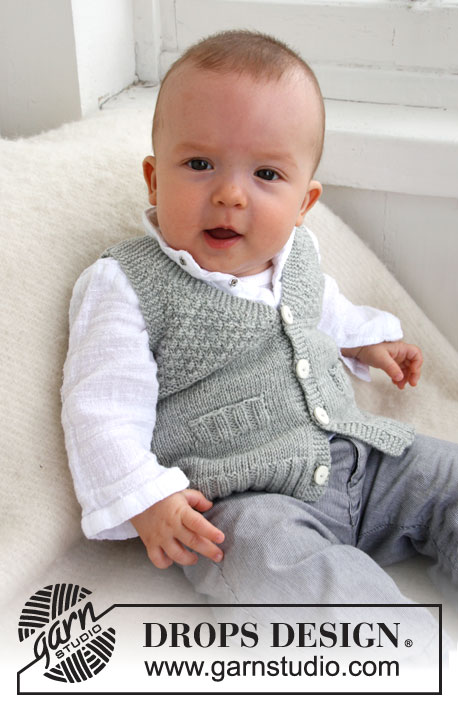 |
DROPS Baby 21-8 Kötött mellény V nyakkivágással, struktúra mintával, kisbabáknak és gyerekeknek, DROPS BabyMerino vagy DROPS Baby Alpaca Silk fonalból
DROPS Baby 21-8 |
|
|
LUSTAKÖTÉS (a kötőtűn oda-vissza): Minden sorban sima szemekkel kötünk. Dupla rizsminta: 1. sor: * 2 sima, 2 fordított. * Ismételjük a *-* közötti részt 2. sor: Folytassuk a kötést, a sima szemeket simán, a fordított szemeket fordítottan kötjük. 3. sor: A sima szemeket F, a fordított szemeket S kötjük. 3. sor: 4. sor: Mint a 2. sort / kört. Ismételjük a 1- 4. sort / kört. GOMBLYUKAK: A gomblyukakat a jobboldali gomboláspánton készítjük el: 1 gomblyuk= kössük össze a 2.és a 3. szemet az eleje közepénél, majd 1RH. A gomblyukakat akkor készítjük, amikor a darabunk 1/3 hónapos babákra való méretnél: 2, 6, 10 és 14 cm. 6/9 hónapos babákra való méretnél: 2, 7, 11 és 16 cm. 12/18 hónapos babákra való méretnél: 2, 7, 12 és 17 cm. 2 éveseknek való méretnél: 2, 8, 13 és 19 cm. 3/4 éveseknek való méretnél: 2, 8, 14 és 20 cm. Fogyasztás a V nyakkivágáshoz a dupla rizsmintában. Minden fogyasztást a színe oldal felől készítünk. A gomb. pánt + ujja szegélye előtt a következő módon készítjük a fogyasztásokat: Amikor az utolsó szem S szem: 2 szemet simán összekötünk. Amikor az utolsó szem F szem: 2 szemet fordítottan összekötünk. A gomb. pánt + ujja szegélye után a következő módon készítjük a fogyasztásokat: Amikor az 1 szem S szem: Egy szemet simán leemelünk, egy sima, és a leemelt szemet az lekötött szemen áthúzzuk Amikor az 1 szem F szem: 2 szemet csavart-F összekötünk (vagyis a szemek hátsó "lábába" öltünk az első helyett). -------------------------------------------------------- -------------------------------------------------------- TESTRÉSZ: Körkötőtűn kötjük, oda-vissza az eleje közepétől kezdve. A kezdéshez szedjünk fel 148-168-184 (204-224) szemet a 2,5 mm-es körkötőtűre, a Baby Merino fonalból. A következő színe oldali sorban így kössük 5 szem lustakötéssel (= gomb pánt) - lásd a fenti magyarázatot. * 2 S / 2 F bordás minta. * Ism a *-* közötti részt, amíg 7 szem marad, 2 S 5 szem lustakötéssel (= gomb pánt) fejezzük be a sort. Folytassuk a bord mintával a fentiek szerint, 5-5 szem lustakötéssel a darab mindkét oldalán, amíg a darabunk 3-3-4 (4-5) cm-es lesz. Ne felejtsük elkészíteni a GOMBLYUKAKAT a jobboldali gomboláspánton- lásd a fenti magyarázatot! Váltsunk az 3 mm vastag körkötőtűre, és folytassuk harisnyakötéssel (a gomb pánt szemeit a korábbiaknak megfelelően lustakötéssel kötjük tovább): UGYANAKKOR, a bord minta utáni 1. sorban egyenletesen elosztva fogy 32-36-40 (44-52) szemet = 116-132-144 (160-172) szem. Tegyünk 1 jelölőt a darabba, mindkét oldaltól 31-35-39 (43-45) szemnyire =54-44-62-66 (74-82) szem marad a két jelölő között a hátához). NE FELEDKEZZÜNK MEG A MEGFELELŐ KÖTÉSPRÓBA BETARTÁSÁRÓL! Amikor a darabunk 7-7½-8 (9-10) cm-es, a következő színe oldali sorban így haladjunk: 5 szem lustakötéssel, 21-21-27 (27-31) szem harisnyakötéssel, csúsztassuk az utolsó 16-16-20 (20-24) lekötött szemet szemtartóra a zseb hasítékához, kössünk, amíg 10-10-12 (12-12) szem marad a kötőtűn. Csúsztassuk az utolsó lekötött 16-16-20 (20-24 szemet szemtartóra a zseb hasítékához, kössünk 5-5-7 (7-7) szemet harisnyakötéssel, és a sort 5 lustakötéses szélszemmel fejezzük be. A következő sorban szedjünk fel 16-16-20 (20-24) új szemet a 2 szemtartóra tett szemek felett = 116-132-144 (160-172) szem. Folytassuk harisnyakötéssel, és lustakötéssel, amíg a darabunk 13-14-16 (16-18) cm-es lesz. Most kössünk 4 sort sima szemekkel minden szemen (= 2 bordányit, lustakötéssel). Most folyt a dupla rizsmintával - olvassuk el a fenti magyarázatot- és a gomb pántokon a lustakötéses szemekkel a korábbiaknak megfelelően folytatjuk a munkát. MIELŐTT FOLYTATNÁNK A MUNKÁT OLVASSUK EL A TELJES HÁTRA LÉVŐ RÉSZT: Amikor a darabunk 15-17-18 (20-21) cm-es, kössünk 2 sort lustakötéssel a kötőtűn levő első 5 szemen (a többi szemet nem kötjük le), majd kössünk 1 sort minden szemen. Kössünk 2 sort lustakötéssel az első 5 szemen, a darab másik oldalán (így a V nyakkivágás szebben áll majd. Ezután fogyasszunk a V nyakkivágás kialakításához - lásd a fenti magyarázatot! 1 SZEMET fogy minden 2. sorban (vagyis minden SZO felőli sorban) összesen 12-13-16 (16-16) alkalommal. UGYANANKOR, Amikor a darabunk 16-17-19 (3720-22) cm-es kössünk 4 bordányit lustakötéssel a középső 18-20-20 (20-20) szemen mindkét oldalon (vagyis mindkét jelölő mindkét oldalán 9-10-10 (10-10) szemen). a TÖBBI SZEMEN A KORÁBBIAKNAK MEGFELELŐEN FOLYTATJUK A MUNKÁT. A köv sorban mindkét oldalon láncoljuk le a középső 8-10-10 (10-10) szemet a karöltő kialakításához, és az elejét és a hátát külön-külön fejezzük be. HÁTA: = 46-52-56 (64-72) szem. Folytassuk a dupla rizsmintával, és 5 lustakötéses szemmel a két szélén (= az ujja széle).). UGYANAKKOR fogyasszunk a karöltők kialakításához - OLVASSUK EL A FENTI LEÍRÁST. 1 szemet fogy minden 2. sorban (vagyis minden SZO sorban) összesen 5-6-6 (6-6) alkalommal = 36-40-44 (52-60) szemünk marad a kötőtűn a sorban. Folytassuk a dupla rizsmintával, és a lustakötéssel, amíg a darabunk 24-26-29 (31-34) cm-es lesz. Majd lustakötéssel folytatjuk minden szemen, a teljes méretig. UGYANAKKOR, mikor a darabunk kb 25-27-30 (32-35) cm-es láncoljuk le a középső 16-18-20 (20-24) szemet a nyakkivágáshoz = 10-11-12 (16-18) szem marad a kötőtűn mindkét vállhoz. Most a két vállrészt külön-külön fejezzük be. Folytassuk lustakötéssel, amíg a darabunk 26-28-3133-36-78 cm-es lesz, majd láncoljuk le a szemeket. BAL ELEJE: Folytassuk a dupla rizsmintával, és a lustakötéssel, miközben UGYANAKKOR, a karöltő kialakításához, az oldalán szemeket fogyasztunk a hátához hasonló módon, és folyt a fogyasztást a V nyakkivágás kialakításához a korábbiak szerint. Miután minden fogyasztást elkészítettünk 10-11-12 (16-18) szem marad a kötőtűn. Kössünk lustakötéssel minden szemen, amíg a darabunk 26-28-31 (33-36) cm-es lesz. Láncoljuk le a szemeket JOBB ELEJE: Ugyanúgy készítjük, mint a bal eleje darabot, de annak tükörképeként. A ZSEB HASÍTÉKA: Csúsztassuk a szemtartóra félretett 16-16-20 (20-24) szemet az egyik elején vissza a 2,5 mm-es körkötőtűre. Kössünk a bordás mintával (2 S 6 2 F), oda-vissza haladva, 1 lustakötéses szemmel, és 2 S szemmel mindkét oldalon (a SZO felől nézve). Amikor a zseb hasítéka kb 2½-2½-3 (3-3) cm-es lazán láncoljuk le a szemeket, a S szemeket simán, a F szemeket fordítottan. Varrjuk a zseb hasítékát mindkét oldalon az elejére. Varrjuk a zseb nyílását a zseb hasítékának aljéra (ahol a szemeket a szemtartóra tettük) a háta darabot. A másik elején ugyanilyen módon készítsünk egy másik zsebet. ÖSSZEÁLLÍTÁS: Varrjuk össze a vállvarrásokat. Varrjuk fel a gombokat. |
|
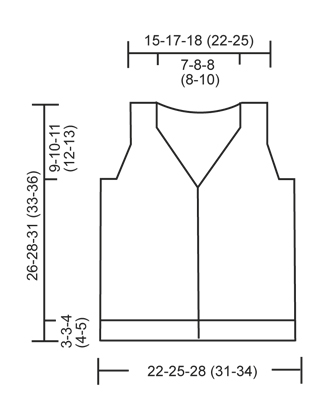
|
|
Elkészítette ezt a mintát?Akkor adja a képeihez a #dropspattern #juniorvest tageket, vagy küldje be a képet a #dropsfan galériába. Segítségre van szüksége a modell elkészítéséhez? 13 tutorial videót találhat, és egy kérdés/felelek részt, és még többet, ha a mintát megkeresi a garnstudio.com oldalán. © 1982-2025 DROPS Design A/S. Minden jog fenntartca. Ez a documentim, az összes részével védelem alatt áll. A weboldalunkon többet olvashat arról, hogy mit tehet és mit nem a mintáinkkal. |
|








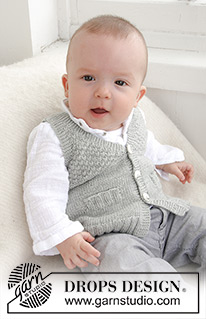

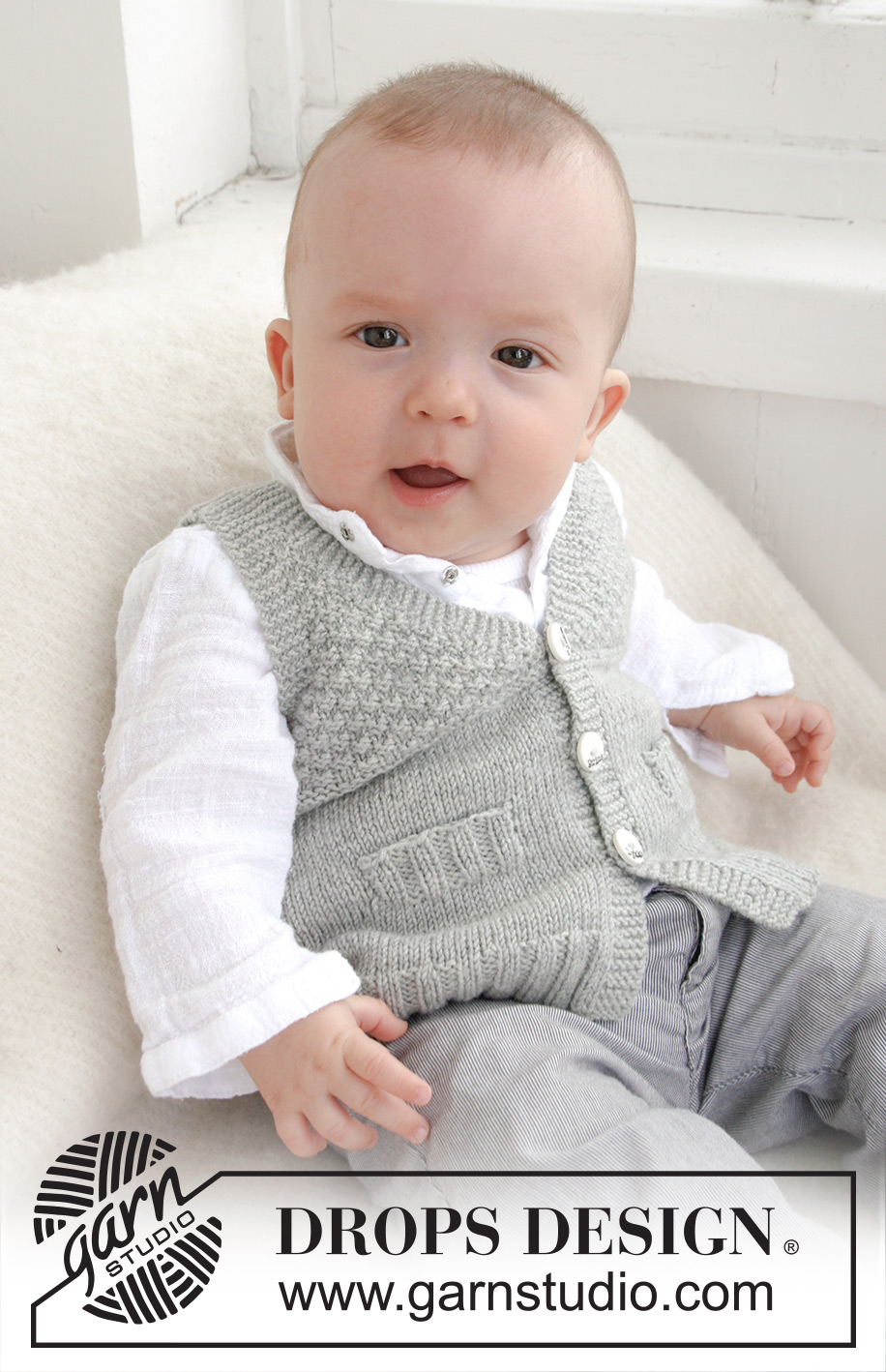

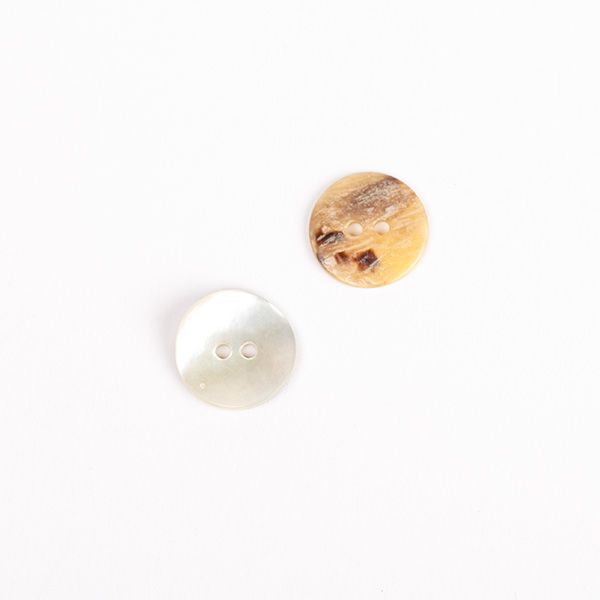

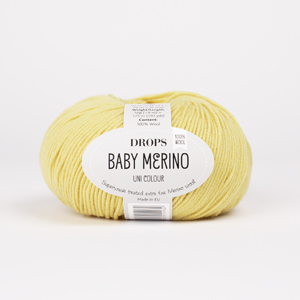
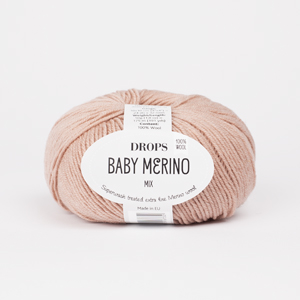






























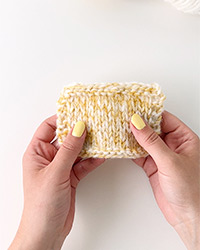
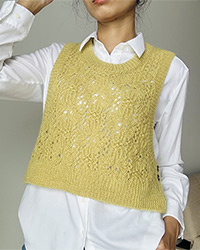

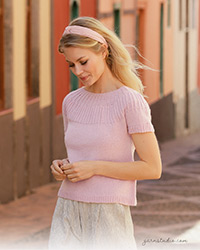
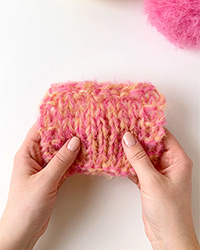
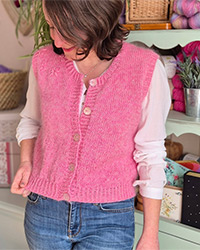
Post a comment to pattern DROPS Baby 21-8
Szívesen vesszük, ha megosztja velünk gondolatait erről a mintáról.
Ha kérdést szeretne feltenni, ügyeljen arra, hogy a megfelelő kategóriát válassza ki, így fegyorsíthatja a válaszadás folyamatát. Það verður að merkja við svæði merktri með *.